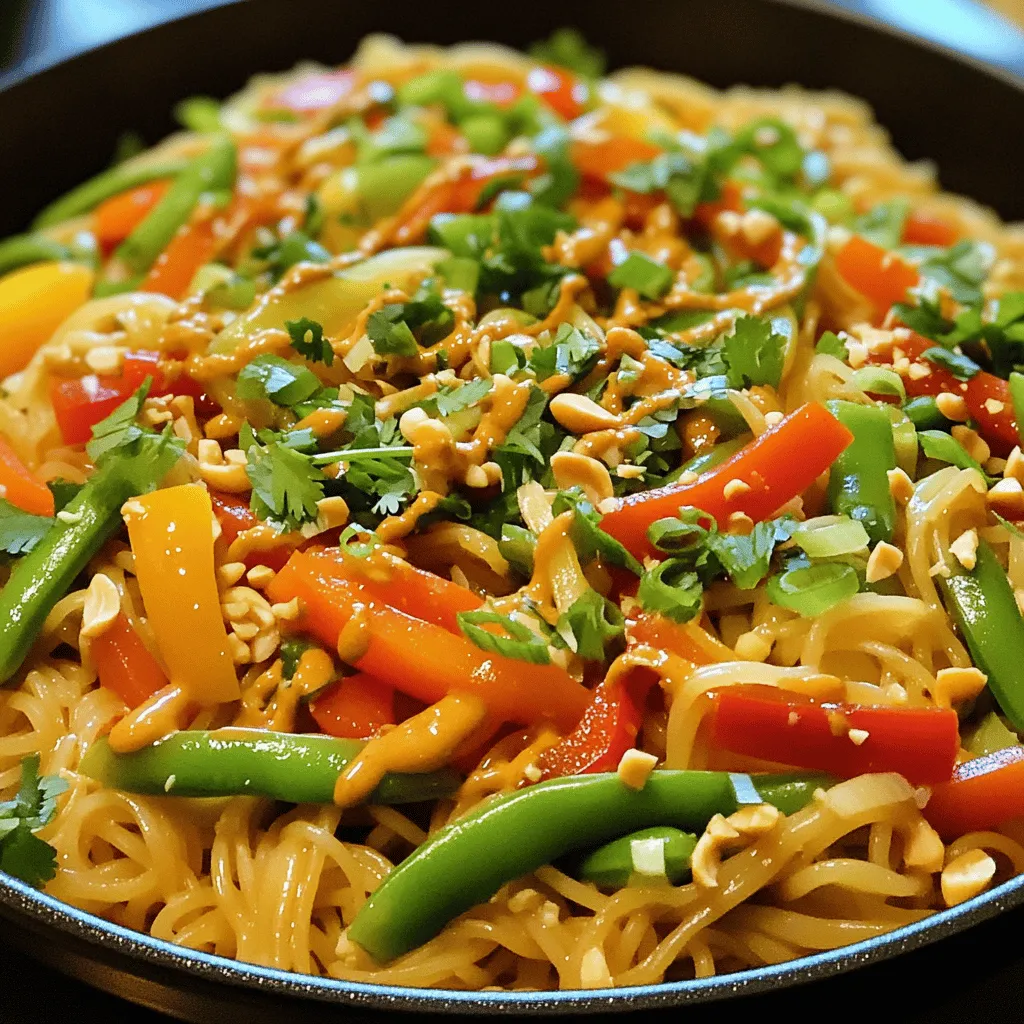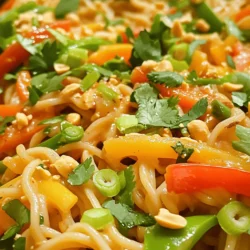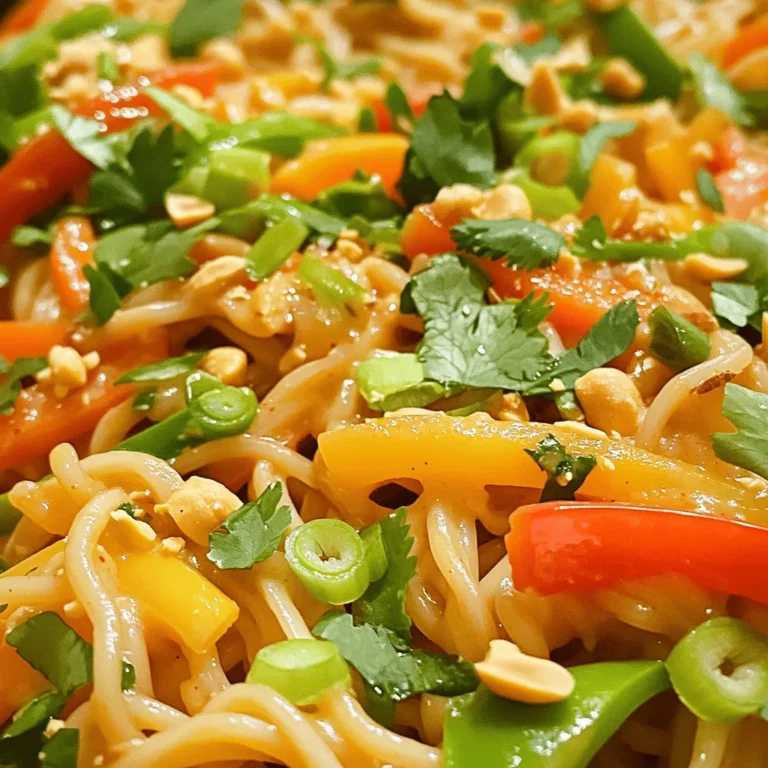Looking for a quick, delicious meal? Try my Spicy Thai Peanut Noodles! This flavorful dish combines rice noodles with a tasty peanut sauce and fresh veggies. It’s simple to make, and you can adjust the spice to fit your taste. In just a few minutes, you’ll have a satisfying meal that packs a punch. Let’s dive into the ingredients and get cooking!
Ingredients
Main ingredients for Spicy Thai Peanut Noodles
– 8 oz rice noodles
– 1 cup bell peppers (mixed colors), thinly sliced
– 1 cup carrots, julienned
– 1 cup snap peas, trimmed
– 1/4 cup green onions, chopped
– 1/4 cup roasted peanuts, roughly chopped
Essential pantry items
– 1 tablespoon sesame oil
– 2 cloves garlic, minced
– 1 tablespoon fresh ginger, minced
– 1/4 cup creamy peanut butter
– 3 tablespoons soy sauce
– 1 tablespoon sriracha (adjust to taste)
– 1 tablespoon lime juice
– Salt and black pepper to taste
Optional garnishes
– Fresh cilantro, for garnish (optional)
For this recipe, I love using fresh veggies. They add color and crunch. The rice noodles give a soft base. Don’t forget the roasted peanuts; they add a nice crunch. The peanut butter adds creaminess to the sauce.
The sesame oil brings a nutty flavor to the mix, while garlic and ginger give it a warm, spicy kick. Adjust the sriracha for your spice level. If you want more heat, add a bit more.
You can make this dish your own. Swap out the veggies or add protein.
Step-by-Step Instructions
Cooking the noodles
To start, bring a large pot of water to a boil. Add 8 oz of rice noodles. Cook them until they are al dente, following the package instructions. This usually takes about 4-6 minutes. Once cooked, drain the noodles in a colander. Rinse them under cold water to stop the cooking. This step keeps the noodles from sticking together.
Stir-frying the vegetables
In a roomy skillet, heat 1 tablespoon of sesame oil over medium-high heat. Once the oil is hot, add 2 minced cloves of garlic and 1 tablespoon of minced fresh ginger. Stir for about 30 seconds until they smell nice. Next, toss in 1 cup of thinly sliced bell peppers, 1 cup of julienned carrots, and 1 cup of trimmed snap peas. Stir-fry the veggies for 3-4 minutes. You want them tender but still crisp.
Making the peanut sauce
Grab a small bowl and whisk together 1/4 cup of creamy peanut butter, 3 tablespoons of soy sauce, 1 tablespoon of sriracha, and 1 tablespoon of lime juice. Mix until smooth. If your sauce is too thick, add warm water a bit at a time. Adjust it until you like the consistency.
Combining noodles and sauce
Now, add the cooked noodles to the skillet with the vegetables. Pour the peanut sauce over everything. Toss it all together until the noodles are well coated. Heat through for 2-3 minutes. You want everything nice and warm.
Finishing touches
Finally, stir in 1/4 cup of chopped green onions and 1/4 cup of roughly chopped roasted peanuts. Give it a taste and add salt and black pepper as needed.
Tips & Tricks
Perfecting the dish
To make the best spicy Thai peanut noodles, focus on the noodles first. Cook the rice noodles according to the package. Aim for an al dente texture. This means they should be firm but not hard. Overcooking can lead to mushy noodles. After cooking, rinse them under cold water. This halts the cooking and keeps them from sticking.
Balancing flavors is key. Start with a base of peanut butter and soy sauce. Adjust the spice with sriracha. If it’s too spicy, add more peanut butter or lime juice. If it’s too sweet, a dash of soy sauce can help. Taste as you go, and don’t be afraid to change things up!
Presentation ideas
Serving your noodles well can make a big difference. Use bright bowls to highlight the colors of the dish. Place the noodles in the center, then arrange the vegetables around them. This creates a beautiful dish that invites you to dig in.
Garnishing is also important. Sprinkling fresh herbs brightens the flavors. Add crushed peanuts for texture. A drizzle of sriracha can also enhance the visual appeal. A little lime wedge on the side can add a splash of color.
Cooking at scale
If you want to double the recipe, it’s simple. Just multiply each ingredient by two. Make sure you have a big enough pot for the noodles. A larger skillet or wok helps with the stir-frying.
This dish is perfect for meal prep. Cook a big batch, then store it in the fridge. It tastes great the next day and makes for easy lunches. Just reheat it in the microwave or on the stove. Enjoy your delicious, easy meal anytime!

Variations
Protein additions
You can easily add protein to your spicy Thai peanut noodles. Try chicken, shrimp, or tofu. For chicken, cook it in the skillet before adding the veggies. Shrimp cooks fast, so toss it in with the vegetables. Tofu is great for a vegetarian option. Use firm tofu, drain it, and cut it into cubes. Sauté it until golden for a nice texture.
Vegetarian alternatives are simple. You can use tempeh or chickpeas for plant-based protein. Both options work well and absorb flavors nicely.
Vegetable substitutions
Feel free to swap out vegetables based on what you have. Broccoli, zucchini, or mushrooms can work great too. You can also mix in spinach or kale for a boost of nutrients. Seasonal vegetables add freshness. In summer, use fresh corn or cherry tomatoes. In winter, try root veggies like sweet potatoes or butternut squash.
Gluten-free options
If you need a gluten-free meal, there are easy swaps. Use gluten-free soy sauce or tamari in place of regular soy sauce. For the noodles, look for rice noodles made from 100% rice. Check the label to be sure they are gluten-free.
When prepping, keep your work area clean. Use separate utensils for gluten-free items. This helps avoid cross-contamination. Enjoy your dish worry-free with these simple adjustments!
Storage Info
Storing leftovers
To keep Spicy Thai Peanut Noodles fresh, store them in an airtight container. Place them in the fridge right after they cool. This helps keep them safe to eat. You can keep them for 3 to 5 days. If you notice any strange smell or mold, throw them away.
Freezing recommendations
You can freeze these noodles if you have extra. First, let them cool completely. Then, place them in a freezer-safe bag or container. Remove as much air as possible. The noodles can last up to 2 months in the freezer. To keep the taste and texture, freeze the sauce separately. This way, you can enjoy the flavors fresh when you reheat them.
Reheating methods
To reheat, use the stovetop or microwave. The stovetop method keeps the noodles from getting too soft. Warm a pan over low heat and add a splash of water. Stir until heated through. For the microwave, place the noodles in a bowl. Add a little water, then cover loosely. Heat in short bursts, stirring in between. This helps keep the noodles moist and tasty. Enjoy your quick meal!
FAQs
Can I make Spicy Thai Peanut Noodles ahead of time?
Yes, you can prep many ingredients ahead of time. Cook the noodles and store them in the fridge. You can cut the veggies and keep them in an airtight container. Mix the peanut sauce and store it separately. When you want to eat, just stir-fry the veggies and heat everything together. This method saves time on busy days.
What can I substitute for peanut butter?
If you need a nut-free option, try sunflower seed butter or tahini. Both give a creamy texture and good flavor. You can also use soy nut butter. Just make sure to check for allergens if you serve it to others.
Is Spicy Thai Peanut Noodles gluten-free?
Yes, Spicy Thai Peanut Noodles can be gluten-free. Use rice noodles instead of wheat noodles. For the sauce, choose a gluten-free soy sauce or tamari. Always read labels to avoid hidden gluten in sauces and ingredients.
How spicy are these noodles?
The spice level depends on how much sriracha you add. If you love heat, add more sriracha. For less heat, start with a small amount and taste as you go. You can also add a dash of chili flakes for extra kick.
Can I add more vegetables?
Absolutely! You can add broccoli, zucchini, or bok choy. Spinach or kale also works great. Adding more veggies boosts nutrition and color. Just make sure to cut them small so they cook evenly with the noodles.
Spicy Thai Peanut Noodles are easy to make and packed with flavor. You learned key ingredients, cooking steps, and tips to perfect your dish. By customizing toppings and proteins, you can make it your own. Storing and reheating methods ensure you enjoy leftovers too. Experiment and find your favorite mix! Cooking can be fun, and these noodles show that. Try it out and savor each bite. This meal is sure to please.


